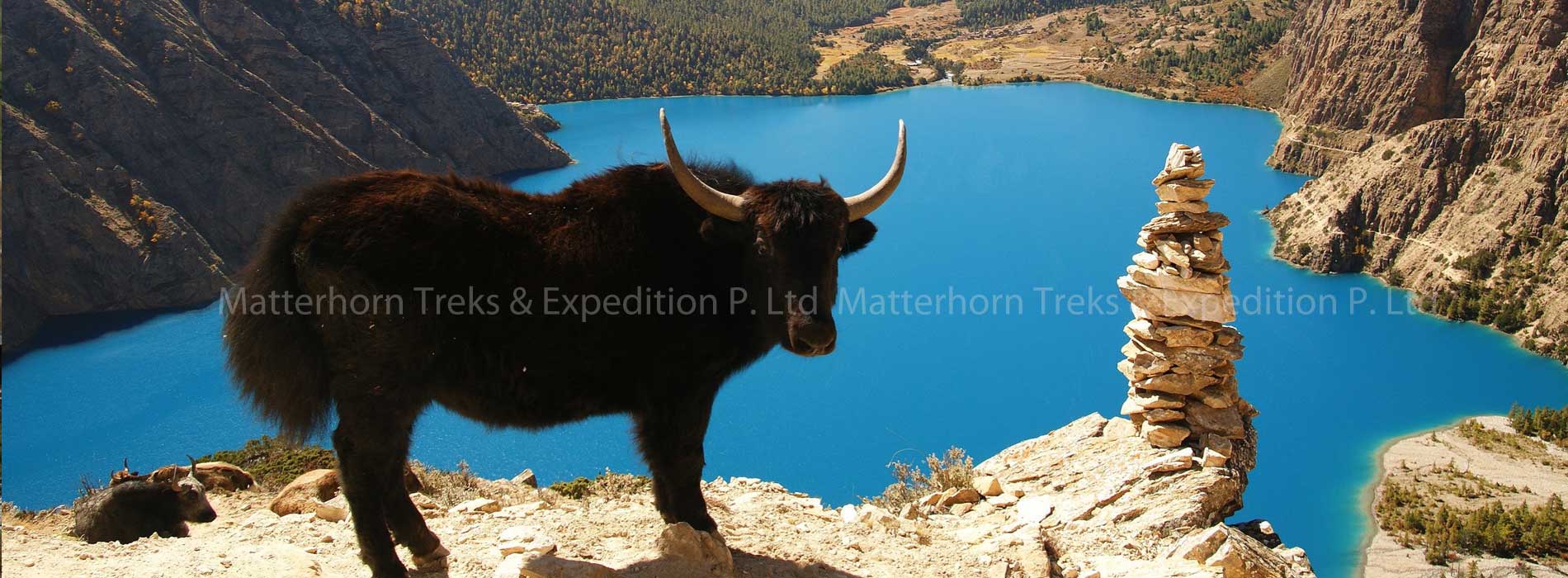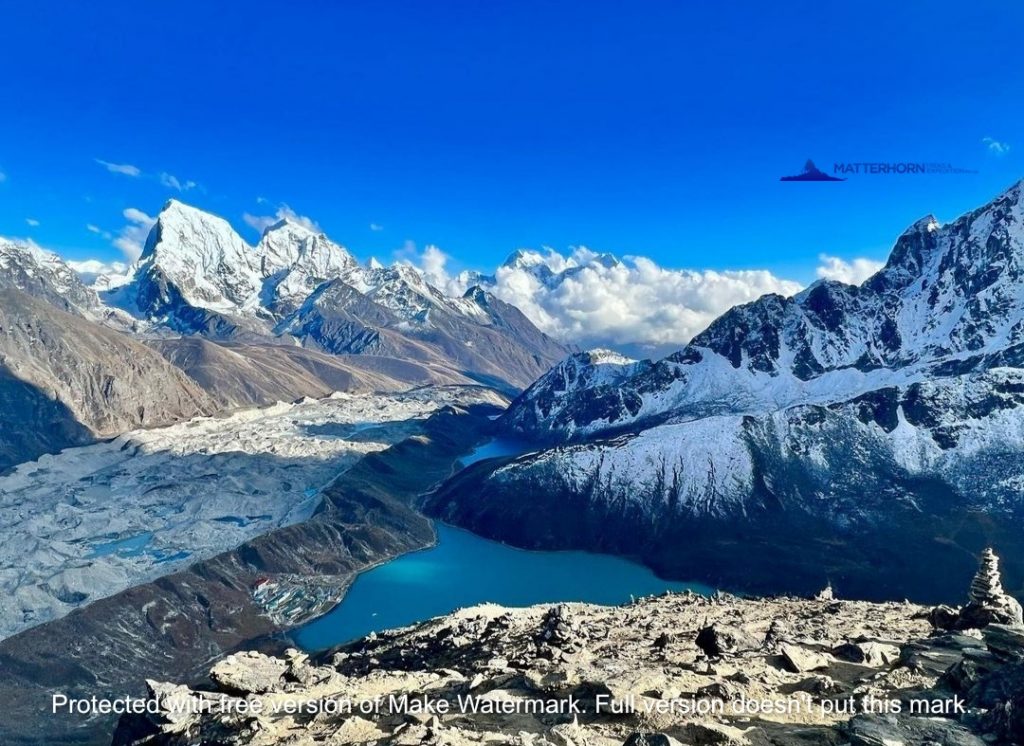
Dolpa which is also called “Ba Yul” or the hidden valley is a land of mystery, scenery and peace and is surrounded by Dhaulagiri and Tibet from South and North. The Dolpo region is the natural embodiment of high passes, rare flora and fauna and sweeping vistas. All the trekking areas in this region stretch through and around Arun River whose origin dates back to the prehistoric period. The Dolpo region was opened for the foreigners since 1990. The Dolpo region is located inside the Shey-Phoksundo National Park in mid-western Nepal, behind the Dhaulagiri massif, towards the Tibetan plateau. The region offers opportunities to visit ancient villages, high passes, beautiful Lakes, isolated Buddhist monasteries and also to experience the vast array of wildlife inhabiting the region, including Blue sheep, Mountain Goat, Jackal, Wolf and the legendary Snow Leopard. This remains a truly isolated corner of Nepal, time has stood still here for centuries as inhabitants of Tibetan stock continue to live, cultivate and trade. Most treks into Dolpo take from 14 to 30 days. The best time to trek here is towards the end of the monsoon season Sept to November. Shorter Dolpo treks are possible by flying into the air strip at Jumla. In the far reaches of Northwestern Nepal lies the extreme landscape of Lower Dolpo. The route begins by meandering through pine and cedar forest with views of the massive Dhaualgiri range in the background. The entrance to Dolpo lies beyond the Jangla Bhanjyang Pass, (4500m). At the head of the valley lay snow-capped peaks and the desolate Tibetan plateau beyond. Protected from rain, this region is dry where the Dolpo inhabitants have carved out a niche of survival in the harsh surroundings by trading with nearby Tibet. A vision of beauty, the Phokshindo (Ringmo) and the legendary monastery of the pre-Buddhist Bonpo sect is our momentous destination. As the most remote and least developed district in Nepal, this trek is reserved for those with a true sense of adventure.
Day 01: Arrival in Kathmandu
Arrival in Kathmandu Tribhuvan International Airport, a representative from Matterhorn Treks & Expedition will transfer to your hotel, We will brief about your trip activities. You’ll have rest of the day at leisure & Overnight at Hotel
Day 02: Kathmandu Sightseeing
Sightseeing in Some of landmarks that are the World Heritage Sites of Kathmandu Durbar Square, the sacred Hindu temple of Pashupati Nath, the famous ‘Monkey Temple’ (Swayambhu Nath) and Buddhists shrine (Bouddha Nath). You can also make your last minute buying of personal items and preparation for the next day.Overnight at Hotel
Day 03: Flight Kathmandu – Nepalgunj
To get to Dolpa, generally you have to fly to Nepalgunj first. Nepalgunj is a steaming hot city in South Western Nepal, in the lowlands of Terai, close to the Indian border, which is just 8 km away. Culturally the areas more resemble India than upland Nepal. Take a cycle rickshaw for a ride in town. You pass the hustle and bustle of the bazaar and see horse carts full of colourful people going to or coming from the Indian border. The Bageshowri temple is one of Nepal’s most important Hindu temples and is worth a visit as well.
Day 04: Flight Nepalgunj – Juphal (2475 m), walk to Dunai
It’s just a 35 minutes flight to Juphal over steep mountain ridges with beautiful views of snowcapped mountains. Juphal airport is just a gravel airstrip amidst the mountains, which guarantees a spectacular landing. Stepping out of the plane, you enter in a completely different world. From a hot city in the plains, you arrive in a small mountain village, situated in the midst of the Himalaya, breathing in crispy cold air.Overnight at Camping.
Day 05: Trek to Tarakot [2,543 m]: 5-6 hrs walk
After breakfast we start our trek continues along the south bank of the river heading upstream on a good trail. Deep gorges, hanging bridges and isolated villages. A tremendous gorge with pine trees and an ingenious path built about seven meter above the river. The colorful terraced field of Tarakot greets us. Tarakot is an old fortress town built by the local people as Dzong or fort.Overnight at Camping.
Day 06: Trek to Laini [3,160 m]: 6-7 hrs walk
After breakfast, we continue our walking to follow the Tarap chu river upstream, crossing by bridge and crossing the same river twice. The famed Sandul Gompa lies farther east from Tarakot and at the junction of Barbung khola and Tarup chu River. The path leads through the farm terraces and rural villages.Overnight at Camping.
Day 07: Trek to Nawarpani [3,545 m]: 5 hrs walk
After breakfast we continue walking up to the gorge of the Tarap River, rising high above on a trail built out from steep slopes. The walk is quite exciting as the valley becomes narrow gorge that in some places you can jump from one side to another. Descend to Chyugur Khola. Sometimes the path vanishes for a while, making our own path across stone slabs fitted on logs in between the walls which act as a bridge.Overnight at Camping.
Day 08: Trek to Do Tarap [4,090 m]: 7-8 hrs walk
Our morning walk begins after breakfast with a gradual up leading us at Kamattarka at the confluence of the Tarap Chu and Lang Khola, a stream flowing from the east. After few hours of good morning walk leaving the narrow gorge, from here the path leads just above tree lines for juniper bush and wild rose, typical of dry inner Himlayan valleys. Another 3 hours or more walk brings us to the village of Dho Tarap surrounded by an irregular stone wall. In this Valley both Bon Po and Chaiba sects reside together. Tarap is also inhabited by a few Tibetans and mostly Magars who have lived here for many generations.Overnight at Camping.
Day 09:Rest Day at Do Tarap for acclimatization
We spend a rest day in Do Tarap for gradually getting used to the altitude. Time to visit monasteries and enjoy the breathtaking views. Make friends with the locals who have hardly seen westerners. The Dolpo people wear home spun clothing that is sometimes dyed maroon and they favour Tibetan style somba or dhocha (boots with upturned toes) for foot wear. Both men and women often wear religious amulets and strings of coral, amber and turquoise. The people of the region are both Bon po and Nyingmapa of Buddhist sect.Overnight at Camping.
Day 10: Trek to Numa La Base Camp [4440 m]: 6-7 hrs walk
After a wonderful time at Do Tarap, our journey continues towards upper Tarap valley, the walk follows in this plain valley with patched of lush verdant grass on both sides of the river, which is completely different from other parts of inner Dolpo. The trek on this pleasant track leads by the Tarap chu upstream all the way. Tarap is certainly a dream valley with vast plains in high mountains. A few hours’ good walk takes us to the village of Tokyu, it has a monastery belonging to the Chiba sect. After visit this village our walk continues further up this valley climbing up the rough track for almost another three hours to reach our overnight camp beneath the Numa-la.
Day 11: Cross Numa La [5,190 m], and camp at Pelung Tang [4465 m]: 6-7 hrs
This is one of the long and difficult days during the trek. After breakfast our journey continues to crossing of Numa La pass at 5,190 m, the track leads to steep climb all the way to the top ridge of Numa la with great views of the surrounding landscapes. An incredible panoramic view of the barren mountains of Dolpo up to the Dhaulagiri (8167 m). After getting to the top of Numa La we will descend to camp at Pelung Tang.Overnight at Camping.
Day 12: Cross Baga La [5,070 m] and camp Dajok Tang [4,080 m]: 6 hrs
After breakfast our morning trek starts with a steep climb to reach the ridge top of Baga-la at 5,070 m, which offers fantastic views of the surrounding landscapes and of the distant snow capped peaks of Kanjirowa Himal range, after a glorious moment at the pass, almost three hours of downhill walk takes to the Dajok Tang for overnight.Overnight at Camping.
Day 13: Trek to Ringmo (3,600 m): 3- hrs walk
After breakfast our morning trek starts through the pine forest, on leaving the forest behind the country and the vegetation changes for pasture field and alpine shrubs most of the way to Ringmo on the gradual slopes with few ups and downs as we reach our final destination at Ringmo. Overnight at Camping.
Day 14: Rest Day at Ringmo
A rest and exploration day. And of course we sit right on the shore of the spectacular Phoksumdo Lake; remember the harrowing scene in ‘Himalaya’ when Thinley’s yak caravan attempted the ‘Devil’s Trail’. Yak caravans will be heading in and out of Ringmo on their way north towards the border of Tibet, and our most northerly destinations, Saldang and Thinje. This is the pleasant day free from the hassle of packing and chance to visit the nearby Tibetan Buddhist monastery is well worth a visit, as is the village of Ringmo. A walk part way round the lake is also very enjoyable and relaxing.Overnight at Camping.
Day 15: Trek to Renje (3010 m) 5 hours
We back track our path to Ringmo village and continue past Palam to the Suli Gaad valley, following the stream originating from the Phoksumdo Lake. After a descent of almost 900 meters we will arrive in the small village of Renje, which consists of 9 houses on the side of the river. Here we will find a good campsite about 5 minutes from the village).Overnight at Camping.
Day 16: Trek to Chepka (2670 m) 4- hours
Our route follows several ups and downs alongside the river through forests of firs and larches as it continues downstream. The trail then becomes a collection of rocks and sticks forming a dyke along the river bank. We will set up camp beside a huge rock in a walnut grove about 20 minutes away from Chepka overnight at Camping.
Day 17: Trek to Juphal (2354 m) 3 hours
Today we walk to the region famous for its lotus-like plant called chuk, which is used to make vinegar and medicines. We pass through the villages of Ankhe, Rahagaon and Parela, meaning ‘eye’, ‘eyebrow’ and ‘eyelash’ respectively. We keep walking downstream following the river to Dunai. From here we ascend to Juphal climbing through wide meadows. In Juphal we will spend the night in one of its hotels where a well deserved hot shower awaits us.Overnight at Camping.
Day 18: Fly to Kathmandu Nepalgunj : Early morning flight to Nepalganj. This is a wonderful 35-minute flight over the Himalayan foothills, with fine views of the main peaks including Annapurna and Dhaulagiri to the north. You then connect with the flight back to Kathmandu. Overnight at Hotel.
Day 19. Kathmandu
This pleasant day you may have full day at leisure at your own or can be extends your extra trip with us on additional cost or time to explore the Thamel for last day shopping and evening Matterhorn Treks & Expedition will take you for Farewell dinner. Overnight at Hotel
Day 20. Departure from Kathmandu. Matterhorn treks & Expedition will transferred to the International Airport your departure flight to your on wards destination
Fill up the form below to tell us what you're looking for

